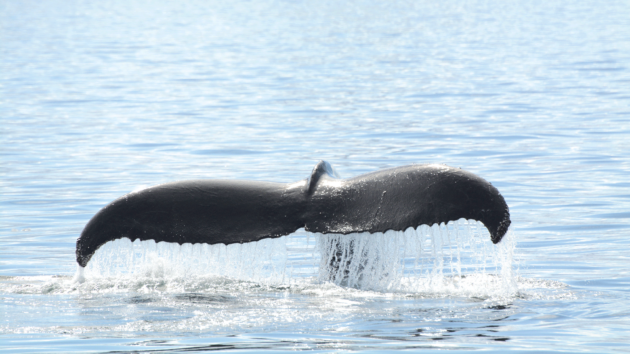Many people follow the motto 'Reduce, reuse, recycle.' We can apply this ethos to sailing to help us reduce our impact on the environment. Here are some top tips for sustainable sailing.
The social narrative pushes us to take responsibility for protecting the natural environment that we sail in. But how exactly can we do that without sucking the joy out of sailing?
Glistening waves, chance dolphin sightings, and breathing in fresh air are enormous motivators for getting out onto a boat. There are a few sustainable sailing habits that will allow us to continue enjoying the natural world for generations to come.

Turn off the motor to save fuel consumption and reduce emissions. Photo: Phil Woollam
Here are some tips based on aims from the World Sailing Organisation’s (WSO) Sustainability Agenda 2030:
1. Sustainable Sailing: Recycle, Reuse, and Reduce Waste
When packing for a sailing trip, take refillable water bottles and containers to avoid single-use plastics. Biodegradable food storage is also a good option.
Separate general waste from recycling and keep it on board until you can dispose of it appropriately on shore. Avoid chucking rubbish overboard, as waste in our oceans harms marine wildlife, ruins the view, and contributes to climate change.
These values align with World Sailing’s Sustainability Agenda, which aims to ‘substantially reduce waste generation through prevention, reduction, recycling, and reuse’ by 2030.

Photo: Karen Eriksen
2. Minimising fuel use
To reduce emissions, dial down motor use. So, if conditions are suitable, let your mainsail and jib do the work. Invest in renewable energy sources to reduce fuel consumption by installing solar panels and a wind or hydro generator.

‘I can sail for days without running my engine at all. My wind generator keeps my batteries topped up, and my autopilot and instruments are powered up every day.’ – Fox Morgan. Photo: Fox Morgan
3. Throw nothing overboard
Carry onboard various containers to separate and compact your waste. Screw-top drums can allow you to compress your rubbish and contain unpleasant smells until you can dispose of it ashore. Use different drums to separate cardboard and paper, organic food waste, plastic, and metal trash. The drums can live outside or in a lazarette. To maximise the containers’ use, crush rubbish with a rubber mallet.
For extra sustainability points, pick up plastic waste that floats nearby.
Article continues below…
Water Bottle Fountain Fund Accepting Applications From UK Coastal Communities
The Sea-Changers Coastal Fountain Fund 2025 is open, allowing not-for-profit organisations to bid for up to £2,500 to pay for…
Join us for the Coppercoat Brian Black Memorial Award 2025
The Brian Black Memorial Award is Yachting Monthly’s marine environmental journalism award with the support of Coppercoat, with cash prizes…
4. Pick plastic-free and sustainable options
Use eco-friendly products when possible while onboard. Reusable containers are an excellent option for food to avoid single-use plastics, as is swapping plastic storage for cardboard or paper ones. Buy unpackaged produce where possible.
Keep your cupboards stocked with the same containers, and refill them repeatedly. By unpacking before you set sail, you can easily dispose of and recycle everything before you cast a line to leave.
There’s also the added benefit of less rubbish to lug ashore.

Reusable water bottles are ideal for reducing single-use plastics. Photo: Sea-Changers Coastal Fountain Fund
To stay hydrated while helping the environment, opt for reusable bottles rather than single-use ones. Metal or silicon straws are a good alternative to plastic ones, which harm marine creatures such as turtles.
5. Respect wildlife
One of the exciting parts about a sailing adventure is spotting marine life, whether it’s a dolphin fin, shoals of fish milling around the boat, or sea birds bobbing on the waves.
To ensure you don’t invade their space, maintain a healthy distance. Stay 100m away from birds nesting on cliffs to avoid scaring them.

Maintain a respectful distance from sea birds. Photo: Albert de Nijs and Claudia Koppeno
6. Use facilities on land where possible
When you need a shower, take a short one on land. As tempting as staying under the warm flow for ages is, using less water in the shower cubicle helps the environment.
Pick non-toxic cleaning and hygiene products to maintain your yacht and reduce the amount of harmful chemicals entering the marine ecosystem.
Enjoyed reading this?
A subscription to Yachting Monthly magazine costs around 40% less than the cover price, so you can save money compared to buying single issues.
Print and digital editions are available through Magazines Direct – where you can also find the latest deals.
YM is packed with information to help you get the most from your time on the water.
-
-
- Take your seamanship to the next level with tips, advice and skills from our experts
- Impartial in-depth reviews of the latest yachts and equipment
- Cruising guides to help you reach those dream destinations
-
Follow us on Facebook, Twitter and Instagram.






